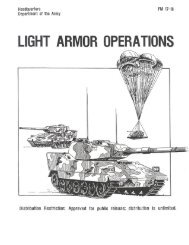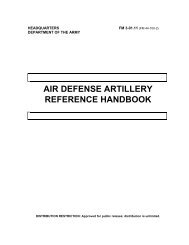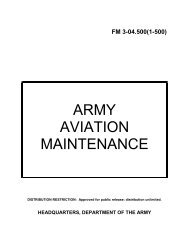fm 44-100 us army air and missile defense operations
fm 44-100 us army air and missile defense operations
fm 44-100 us army air and missile defense operations
Create successful ePaper yourself
Turn your PDF publications into a flip-book with our unique Google optimized e-Paper software.
FM <strong>44</strong>-<strong>100</strong><br />
effectively operate or acquire <strong>and</strong> engage targets. These systems include<br />
radios, radar, jamming systems, direct-fire weapons, <strong>and</strong> <strong>air</strong>borne <strong>and</strong><br />
ground sensors as well as friendly ADA systems. Fields of fire relate to the<br />
terrain effects on weapon systems. Airspace m<strong>us</strong>t be analyzed with regard to<br />
routes that provide the best protection for <strong>air</strong> threats entering the target<br />
area, <strong>and</strong> those that provide the best fields of fire once they reach the target<br />
area.<br />
Cover <strong>and</strong> Concealment<br />
A-11. Cover <strong>and</strong> concealment have slightly different applications with respect<br />
to <strong>air</strong> systems. The following tactics <strong>and</strong> techniques fall into the context of<br />
cover <strong>and</strong> concealment:<br />
• Contour flight. Flight at low altitude conforming generally to, <strong>and</strong><br />
in proximity to, the contours of the earth. It is characterized by<br />
varying <strong>air</strong>speeds <strong>and</strong> altitudes as dictated by vegetation, obstacles,<br />
<strong>and</strong> ambient light. Generally speaking contour is defined as operating<br />
with the skids or wheels between 25 <strong>and</strong> 80 feet above the highest<br />
obstacle.<br />
• Pop-up tactics. Low-level approach to the target area <strong>us</strong>ed by high<br />
speed fixed wing <strong>air</strong>craft such as the F-16. Target acquisition <strong>and</strong><br />
engagement is made by popping up in altitude at a predetermined<br />
position or time to minimize exposure.<br />
• Masking. Using terrain to protect an <strong>air</strong> system from visual <strong>and</strong><br />
electronic observation or detection. Electronic warfare supplements<br />
natural masking.<br />
• Cover. Using terrain to provide protection from direct-fire weapon<br />
systems.<br />
• Ground clutter. Characterized as a reduction of electromagnetic<br />
signal-to-noise ratio due to the signature of a background. It is<br />
different for each type of terrain or feature.<br />
A-12. Fixed <strong>and</strong> rotary wing <strong>air</strong>craft, cruise <strong>missile</strong>s, <strong>and</strong> possibly even UAVs<br />
will <strong>us</strong>e contour flying, masking, <strong>and</strong> ground clutter to avoid detection <strong>and</strong> to<br />
provide cover from direct fires. Aircraft will also <strong>us</strong>e the terrain by loitering<br />
on reverse slopes, <strong>us</strong>ing pop-up tactics, <strong>and</strong> by <strong>us</strong>ing ground clutter <strong>and</strong><br />
vegetation as a backdrop to enhance concealment.<br />
Obstacles<br />
A-13. Obstacles are broken down into three primary types:<br />
• Those which prevent the effective employment of ADA systems.<br />
• Those that restrict contour flight.<br />
• Those that force <strong>air</strong> threats to employ a particular surveillance or<br />
attack profile or route, or to gain excessive altitude.<br />
A-14. Of particular interest are obstacles <strong>and</strong> terrain, which restrict lateral<br />
movement within an avenue of approach. This will canalize movement or<br />
restrict evasive action. Additionally, terrain may stop the employment of<br />
certain <strong>air</strong> threat systems if the terrain exceeds the system's maximum<br />
operating ceiling. Obstacles should be plotted on a modified combined<br />
obstacles overlay (MCOO).<br />
A-3











